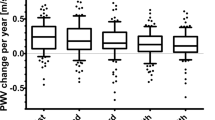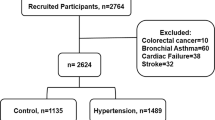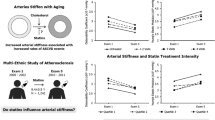Abstract
Proprotein convertase subtilisin/kexin type 9 (PCSK9) is an important circulating serine protease in low-density lipoprotein cholesterol (LDL-C) metabolism. Increased plasma PCSK9 levels lead to increased plasma levels of LDL-C and an increased risk of cardiovascular disease (CVD). LDL-C is positively correlated with arterial stiffness, a surrogate endpoint of CVD. However, whether plasma levels of PCSK9 could influence arterial stiffness is still unclear. Our study examined the relationship between plasma levels of PCSK9 and arterial stiffness (carotid–femoral pulse wave velocity (cf-PWV)) in a community-based population. We analysed the measurements of baseline plasma PCSK9 levels and both baseline and follow-up cf-PWV in 1447 subjects in a 4.8-year longitudinal study. Pearson’s correlation analyses revealed that plasma levels of PCSK9 were not correlated with cf-PWV. Additionally, multiple linear regression analyses using cf-PWV as the dependent variable and adjusting for several potential confounders showed that plasma PCSK9 levels were not significantly correlated with cf-PWV. Thus, our study could not prove an independent relationship between plasma levels of PCSK9 and arterial stiffness.
This is a preview of subscription content, access via your institution
Access options
Subscribe to this journal
Receive 12 digital issues and online access to articles
$119.00 per year
only $9.92 per issue
Buy this article
- Purchase on Springer Link
- Instant access to full article PDF
Prices may be subject to local taxes which are calculated during checkout


Similar content being viewed by others
References
Shimada YJ, Cannon CP . PCSK9 (Proprotein convertase subtilisin/kexin type 9) inhibitors: past, present, and the future. Eur Heart J 2015; 36: 2415–2424.
Seidah NG, Awan Z, Chrétien M, Mbikay M . PCSK9: a key modulator of cardiovascular health. Circ Res 2014; 114: 1022–1036.
Banerjee Y, Santos RD, Al-Rasadi K, Rizzo M . Targeting PCSK9 for therapeutic gains: have we addressed all the concerns? Atherosclerosis 2016; 248: 62–75.
Robinson JG, Farnier M, Krempf M, Bergeron J, Luc G, Averna M et al. Efficacy and safety of alirocumab in reducing lipids and cardiovascular events. N Engl J Med 2015; 372: 1489–1499.
Sabatine MS, Giugliano RP, Wiviott SD, Raal FJ, Blom DJ, Robinson J et al. Efficacy and safety of evolocumab in reducing lipids and cardiovascular events. N Engl J Med 2015; 372: 1500–1509.
Wang F, Ye P, Luo L, Xiao W, Qi L, Bian S et al. Association of serum lipids with arterial stiffness in a population-based study in Beijing. Eur J Clin Invest 2011; 41: 929–936.
Kullo IJ, Malik AR . Arterial ultrasonography and tonometry as adjuncts to cardiovascular risk stratification. J Am Coll Cardiol 2007; 49: 1413–1426.
Vlachopoulos C, Aznaouridis K, Stefanadis C . Clinical appraisal of arterial stiffness: the Argonauts in front of the Golden Fleece. Heart 2006; 92: 1544–1550.
O’Rourke MF, Staessen JA, Vlachopoulos C, Duprez D, Plante GE . Clinical applications of arterial stiffness: definitions and reference values. Am J Hypertens 2002; 15: 426–444.
McEniery C, Cockcroft JR . Does arterial stiffness predict atherosclerotic coronary events? Adv Cardiol 2007; 44: 160–172.
Laurent S, Cockcroft J, Van Bortel L, Boutouyrie P, Giannattasio C, Hayoz D et al. Expert consensus document on arterial stiffness: methodological issues and clinical applications. Eur Heart J 2006; 27: 2588–2605.
Avolio AP, Chen SG, Wang RP, Zhang CL, Li MF, O’Rourke MF . Effects of aging on changing arterial compliance and left ventricular load in a northern Chinese urban community. Circulation 1983; 68: 50–58.
Asmar R, Benetos A, Topouchian J, Laurent P, Pannier B, Brisac AM et al. Assessment of arterial distensibility by automatic pulse wave velocity measurement. Validation and clinical application study. Hypertension 1995; 26: 485–490.
Bai Y, Ye P, Luo L, Xiao W, Xu R, Wu H et al. Arterial stiffness is associated with minimally elevated high-sensitivity cardiac, troponin T levels in a community-dwelling population. Atherosclerosis 2011; 218: 493–498.
Allard D, Amsellem S, Abifadel M, Trillard M, Devillers M, Luc G et al. Novel mutations of the PCSK9 gene cause variable phenotype of autosomal dominant hypercholesterolemia. Hum Mutat 2005; 26: 497.
Cohen J, Pertsemlidis A, Kotowski IK, Graham R, Garcia CK, Hobbs HH et al. cholesterol in individuals of African descent resulting from frequent nonsense mutations in PCSK9. Nat Genet 2005; 37: 161–165.
Fokkema IF, den Dunnen JT, Taschner PE . LOVD: easy creation of a locus-specific sequence variation database using an ‘LSDB-in-a-box’ approach. Hum Mutat 2005; 26: 63–68.
Huijgen R, Boekholdt SM, Arsenault BJ, Bao W, Davaine JM, Tabet F et al. Plasma PCSK9 levels and clinical outcomes in the TNT (treating to new targets) trial: a nested case-control study. J Am Coll Cardiol 2012; 59: 1778–1784.
Leander K, Mälarstig A, Van't Hooft FM, Hyde C, Hellénius ML, Troutt JS et al. Circulating PCSK9 predicts future risk of cardiovascular events independently of established risk factors. Circulation 2016; 133: 1230–1239.
Xie W, Liu J, Wang W, Wang M, Qi Y, Zhao F et al. Association between plasma PCSK9 levels and 10-year progression of carotid atherosclerosis beyond LDL-C: A cohort study. Int J Cardiol 2016; 215: 293–298.
Zhu YM, Anderson TJ, Sikdar K, Fung M, McQueen MJ, Lonn EM et al. Association of proprotein convertase subtilisin/kexin type 9 (PCSK9) with cardiovascular risk in primary prevention. Arterioscler Thromb Vasc Biol 2015; 35: 2254–2259.
Avolio AP, Van Bortel LM, Boutouyrie P, Cockcroft JR, McEniery CM, Protogerou AD et al. Role of pulse pressure amplification in arterial hypertension: experts’ opinion and review of the data. Hypertension 2009; 54: 375–383.
Davies JE, Parker KH, Francis DP, Hughes AD, Mayet J . What is the role of the aorta in directing coronary blood flow? Heart 2008; 94: 1545–1547.
O’Rourke MF, Safar ME . Relationship between aortic stiffening and microvascular disease in brain and kidney: cause and logic of therapy. Hypertension 2005; 46: 200–204.
Chue CD, Townend JN, Steeds RP, Ferro CJ . Arterial stiffness in chronic kidney disease: causes and consequences. Heart 2010; 96: 817–823.
Reference Values for Arterial Stiffness’ Collaboration. Determinants of pulse wave velocity in healthy people and in the presence of cardiovascular risk factors: 'establishing normal and reference values'. Eur Heart J 2010; 31: 2338–2350.
Vlachopoulos C, Aznaouridis K, Stefanadis C . Prediction of cardiovascular events and all-cause mortality with arterial stiffness: a systematic review and meta-analysis. J Am Coll Cardiol 2010; 55: 1318–1327.
Yang SH, Du Y, Li S, Zhang Y, Xu RX, Zhu CG et al. Plasma PCSK9 level is unrelated to blood pressure and not associated independently with carotid intima–media thickness in hypertensives. Hypertens Res 2016; 39: 598–605.
Lakoski SG, Lagace TA, Cohen JC, Horton JD, Hobbs HH . Genetic and metabolic determinants of plasma PCSK9 levels. J Clin Endocrinol Metab 2009; 94: 2537–2543.
Horton JD, Cohen JC, Hobbs HH . Molecular biology of PCSK9: its role in LDL metabolism. Trends Biochem Sci 2007; 32: 71–77.
Gauthier M, Pérusse JR, Awan Z, Bouchard A, Tessier S, Champagne J et al. A semi-automated mass spectrometric immunoassay coupled to selected reaction monitoring (MSIA–SRM) reveals novel relationships between circulating PCSK9 and metabolic phenotypes in patient cohorts. Methods 2015; 81: 66–73.
Acknowledgements
We thank our colleagues in the Department of Laboratory Medicine at the PLA General Hospital for their help with the biochemical measurements. We are also grateful to all of the study participants for their involvement in the study. This research was supported by a grant from the Key National Basic Research Program of China (2012CB517503, 2013CB530804) and the Key Science and Technology Foundation of China (2012ZX09303004-002) to Ping Ye.
Author information
Authors and Affiliations
Corresponding author
Ethics declarations
Competing interests
The authors declare no conflict of interest.
Supplementary information
Rights and permissions
About this article
Cite this article
Han, J., Wang, X., Ye, P. et al. Plasma PCSK9 levels are unrelated to arterial stiffness in a community-based, 4.8-year prospective study. J Hum Hypertens 31, 720–724 (2017). https://doi.org/10.1038/jhh.2017.56
Received:
Revised:
Accepted:
Published:
Issue Date:
DOI: https://doi.org/10.1038/jhh.2017.56



